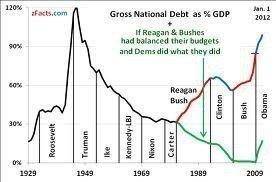В
The federal debt crossed the $16 trillion mark this week. What’s more remarkable than the number of zeros in that figure is that Washington somehow didn’t see this coming. The Congressional Budget Office is responsible for predicting the budgetary effects of policy changes. Politicians cite CBO figures when telling us what to expect in the future. But it turns out that CBO forecasts, taken out of a very limited context, aren’t very accurate.
В
Every January, CBO forecasts the U.S. economy for each of the subsequent 10 years. Since 1997, the agency has underestimated the yearly debt in 85 out of 110 tries.. Almost 80% of the time, the CBO produces (and politicians parrot) a ridiculously optimistic picture of the future.
James R. Harrigan
Ten years ago, the CBO predicted that we’d be $7.6 trillion in debt by now. At $16 trillion, the reality is more than twice as bad. Unfortunately, that’s par for the course. Since 1997, the agency’s forecasts of the debt five or more years into the future have been 40% too low on average — even ignoring the 2008-2009 recession.
Currently, the CBO estimates that the federal debt will hit $25 trillion by 2021. But if that forecast is also off by 40%, we’ll actually be facing a federal debt of $35 trillion by then.
What will our country look like with a $35 trillion debt? The CBO has a good track record of predicting gross domestic product, and it predicts 2021’s economy will exceed $24 trillion. That will put our debt at almost 150% of GDP, or about where Greece is today.
Today the federal government pays a paltry 2.6% interest on its debt. Even if the Federal Reserve can hold rates that low for the next nine years, the U.S. will pay almost $1 trillion in interest in 2021. That’s more than the government currently spends on the national defense budget, more than it spends on Social Security, and more than the cost of the entire Iraq War.
If interest rates return to earlier levels (say, 2003’s 4.7%), 2021’s interest expense will top $1.6 trillion. The CBO predicts that tax revenue in 2021 will be $4.7 trillion. Ignore for the moment that the agency routinely overestimates tax revenue (nine years ago, they projected that 2012’s revenue would be $3.5 trillion; it was actually $2.3 trillion). A $1.6 trillion interest expense will devour over a third of federal tax revenues.
В
Antony Davies
This financial house of cards was decades in the making, and it will take years to correct. Correcting the mess requires four ingredients: freer markets, sound money, restricted spending, and time.
The government can hand us the first ingredient immediately by eliminating regulatory cronyism. Regulations that protect people’s property rights are fine. Regulations that prevent competition or promote politically favored industries are not. Requiring surgeons to be licensed is fine. Requiring hair braiders, flower arrangers, casket makers, beekeepers, and interior designers to be licensed is not. Today, one in three American jobs requires a government-issued license. It used to be one in 20. Government needs to get out of the way of Americans trying to make a living.
The second ingredient comes from returning to the gold standard. Someday economic theory may be advanced enough and computers might be powerful enough to allow humans to manage the money supply well. That day isn’t now and we need to stop tinkering because the tinkerers usually make things worse.
When people are strapped for cash, they make tough choices. It’s time the government did too. We need a constitutional amendment restricting government spending to 20% of GDP or less.
As for the last ingredient, we have little time left. If our leaders do not address these matters quickly, the laws of mathematics will force a solution on us.
В
В
James R. Harrigan is a fellow of the Institute of Political Economy at Utah State University. Antony Davies is a professor of economics at Duquesne University in Pittsburgh.
В

